Related Research Articles
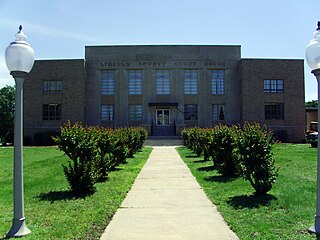
Lincoln County is located between the Arkansas Timberlands and Arkansas Delta in the U.S. state of Arkansas. It is also within the Pine Bluff metro area, and on the outer edge of the Central Arkansas region. The county is named for President Abraham Lincoln. Created as Arkansas's 65th county on March 28, 1871, Lincoln County has three incorporated cities, including Star City, the county seat and most populous city. The county contains 46 unincorporated communities and ghost towns, Cane Creek State Park at the confluence of Cane Creek and Bayou Bartholomew, and nine listings on the National Register of Historic Places to preserve the history and culture of the county.

Chief Plenty Coups State Park is a state park located approximately 0.5 miles (0.8 km) west of Pryor, Montana, on the Crow Indian Reservation. Chief Plenty Coups' (Alek-Chea-Ahoosh) Home, located in the state park, is a National Historic Landmark with several contributing resources. The homestead was listed on the U.S. National Register of Historic Places in 1970 and became a National Historic Landmark in 1999. The 195-acre (79 ha) property belonged to Chief Plenty Coups, the last traditional tribal Chief of the Apsáalooke people. He and his wife, Strikes the Iron, left their home and property to all people in 1928. The only museum of Apsáalooke culture in the United States is located here along with a memorial to Plenty Coups and his achievements.

Hillcrest Historic District is an historic neighborhood in Little Rock, Arkansas that was listed on the National Register of Historic Places on December 18, 1990. It is often referred to as Hillcrest by the people who live there, although the district's boundaries actually encompass several neighborhood additions that were once part of the incorporated town of Pulaski Heights. The town of Pulaski Heights was annexed to the city of Little Rock in 1916. The Hillcrest Residents Association uses the tagline "Heart of Little Rock" because the area is located almost directly in the center of the city and was the first street car suburb in Little Rock and among the first of neighborhoods in Arkansas.

The John Shastid House is a historic house located at 326 E. Jefferson St. in Pittsfield, Illinois. John Shastid, a settler from New Salem, built the house in 1838. The timber-frame house is a well-preserved early example of the construction technique in Illinois. The house was added to the National Register of Historic Places in 2003.

Texarkana Union Station is a historic train station in the Texarkana metropolitan area serving Amtrak, the United States' national passenger rail system. The Arkansas-Texas border bisects the structure; the eastern part, including the waiting room and ticket office, are in Texarkana, Arkansas, but the western part is in Texarkana, Texas, meaning stopped trains span both states. The station was built in 1928 and was added to the U.S. National Register of Historic Places in 1978. Today it is the second busiest Amtrak station in Arkansas.

U.S. Route 62 is a U.S. highway running from El Paso, Texas northeast to Niagara Falls, New York. In the U.S. state of Arkansas, the route runs 329.9 miles from the Oklahoma border near Summers east to the Missouri border in St. Francis, serving the northern portion of the state. The route passes through several cities and towns, including Fayetteville, Springdale, Bentonville, Harrison, Mountain Home, Pocahontas, and also Piggott. US 62 runs concurrent with several highways in Arkansas including Interstate 49 and U.S. Route 71 between Fayetteville and Bentonville, U.S. Route 412 through much of the state, U.S. Route 65 in the Harrison area, and with U.S. Route 63 and U.S. Route 67 in northeast Arkansas.

Blakely House is a dogtrot house located on Arkansas Highway 84 in Social Hill, Arkansas. Greenberry Blakely, one of the first settlers of Hot Spring County, built the house in 1874. The two-room log house is representative of Arkansas homes at the time, as dogtrot houses were popular in the state during the late 1800s. In 1875, Blakely married Martha Ingersell; the couple lived in the home with their two children, Greenberry's mother, and Martha's sister. Blakely placed an addition on the house in 1890 to accommodate his growing family, and in 1890 Blakely sided the home with clapboard. Blakely inhabited the house until his death in 1935.
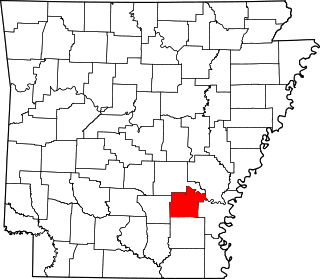
This is a list of the National Register of Historic Places listings in Lincoln County, Arkansas.
Crow House may refer to:
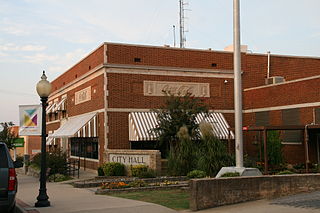
The Coca-Cola Building is a historic commercial building at 211 North Moose Street in Morrilton, Arkansas. It is a two-story masonry structure, built out of red brick with limestone trim. It has relatively clean Colonial Revival lines, with stone string courses between floors, a stone cornice below a parapet, and stone panels carved with the stylized Coca-Cola logo. It was built in 1929 to a design by the noted Arkansas architectural firm Thompson, Sanders & Ginocchio.
Cohn House and variations may refer to:

Union Station is a former railroad station at East 4th Ave. and State St. in Pine Bluff, Jefferson County, Arkansas. The station was originally at the union of the Cotton Belt and Iron Mountain railroads, and now houses the Pine Bluff/Jefferson County Historical Society museum. It is a single-story brick building, with a hip roof whose long eaves are supported by iron columns and half-truss brackets. The station was built in 1906 by the Iron Mountain Railroad. It had been a stop on the St. Louis Southwestern's Lone Star (Memphis-Dallas), and also on the railway's St. Louis-Dallas trains.
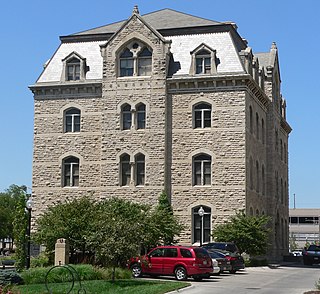
Lincoln City Hall is the former seat of the Lincoln, Nebraska city government. The hall was built from 1874-1879 as the U.S. Post Office and Court House, designed by the office of the U.S. Treasury Department's architect, Alfred B. Mullett. A new post office and court house was built in 1906 and the property was transferred to the city. It was superseded as city hall in 1969 when the city government moved into the City-County Building. Although Mullett is officially listed as the architect, much of the design work may have been carried out by his assistant, William Appleton Potter, who specialized in the Gothic style.
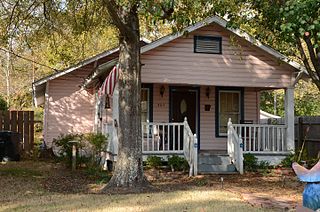
The Oscar Crow House is a historic house at 404 Washington Street in Star City, Arkansas. The single story wood-frame house was built in 1929 by Robert and Doug Verdue for Oscar Crow, owner of a local drug store. The Craftsman style house resembles a shotgun house, but does not exactly follow that form, because its rooms do not progress linearly from the front. The front of the house has a recessed porch supported by box columns, with a vent placed in the gable-end pediment. The front entry is flanked by three-over-one sash windows. The north elevation has four three-over-one windows that are irregularly spaced, and the south side has two such windows, also irregularly spaced. The rear of the house also has a recessed porch. Exposed rafters decorate the roof line.

The Charles Hampton Tracy House is a historic house in rural Lincoln County, Arkansas. It is located at 2794 Blair Road, north and a little east of the county seat of Star City. The single story wood-frame house was built in 1923 by Charles Hampton Tracy, a successful local African-American cotton farmer. The house is a rare local example of Craftsman/Bungalow style, with exposed rafters under the eaves, a hip roof with a prominent gabled dormer, and a front porch supported by square columns on brick piers. The house is an emblem of the success of cotton farming in the area in the years before the Second World War, and the success of an African-American farmer despite the difficulties imposed by Jim Crow laws.

The county courthouse of Lincoln County, Arkansas is located at 300 South Drew Street in Star City, the county seat. The two story building was designed by Wittenberg & Deloney of Little Rock and built in 1943. It is predominantly buff-colored brick, with limestone trim, and has a flat roof that is hidden by a parapet. The building's front, or western, elevation, has a central projecting section that is slightly taller than the wing sections, and is faced primarily in limestone. Four triangular stepped limestone pilasters frame the elements of this section, including the main entrance in the central bay, which now has replacement doors of aluminum and glass. Above the pilasters is a limestone panel identifying the building as the "Lincoln County Courthouse" in Art Deco lettering. It is believed to be the only Art Deco building in the county.

The Parker House is a historic house on United States Route 425, two miles south of Star City, Arkansas. The two story house was built in 1927 by Robert Preston Parker, and it exhibits International style with Mediterranean elements, and extremely unusual styling for a rural setting in southeastern Arkansas. Parker, its builder and first occupant, was a civil engineer with extensive railroad experience. He was responsible for surveying Star City and naming most of its streets, as well as designing a number of other local buildings.
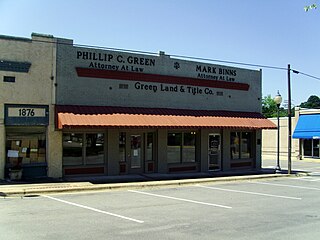
The Star City Commercial Historic District encompasses the historic commercial center of Star City, Arkansas, the county seat of Lincoln County. The district consists of thirteen buildings on two city blocks, as well as the Star City Confederate Memorial. The buildings are located on Jefferson Street, between Arkansas and Bradley Streets, and on Bradley Street between Jefferson and Drew Streets. The memorial is located in the town square, near the junction of Jefferson and Bradley. The buildings in the district were built between 1916 and 1928, and have for the most part escaped major alterations since their construction. Minor changes generally involve changes to store fronts, such as the boarding over of transom windows, the replacement of recessed entries with flush ones, and changes to the fenestration. The building at 108 Jefferson, built in 1927 to house a bar, has been extensively remodeled and does not contribute to the district's significance; the Star Theater building at 212-214 Bradley has also been extensively altered.

The Habicht-Cohn-Crow House is a historic house at 8th and Pine in Arkadelphia, Arkansas. The single-story Greek Revival house was built in 1870 for Captain Anthony Habicht. Habicht sold the house in 1875 to M. M. Cohn, the founder of the regional MM Cohn department store chain. Cohn sold it five years later to A. M. Crow, a local land agent for the railroad.
The Joe Brown House and Farmstead is a historic property in rural White County, Arkansas. It is located about one mile south of the end of County Road 529, and about 2 miles (3.2 km) north of the hamlet of Little Red as the crow flies. It is a single-story dogtrot house, with a corrugated metal roof and board-and-batten siding. The front facade has a shed-roof porch extending across part of the front, sheltering two entrances giving access to the two pens and the breezeway. The property includes a well and the remains of a log smokehouse. The house was built about 1890, and is one of White County's few surviving 19th-century dogtrots.
References
- 1 2 "National Register Information System". National Register of Historic Places . National Park Service. July 9, 2010.
- ↑ "Crow House, Star City Vic., Lincoln County". Arkansas Preservation. Archived from the original on 2014-04-18.